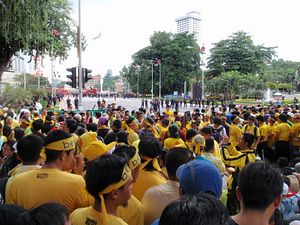Under the tagline “Satukan Tenaga – Malaysia Baru” (“Stand United – New Malaysia”), Bersih 2.0 kicked off its seven-week nationwide roadshow on October 1, with six convoys making their way through six regions across Malaysia: Northern Peninsular (Kangar, Perlis), Southern Peninsular (Johor Bahru, Johor), East Coast (Kota Bharu, Kelantan), West Coast (Lumut, Perak), Sabah (Sandakan) and Sarawak (Miri). The ambitious month-long roadshow, which will cover 246 cities, towns, and villages, aims to mobilize support for Bersih 2.0’s cause ahead of the upcoming Bersih 5 rally scheduled on November 19 in Kuala Lumpur.
This year marks the 10th anniversary of the formation of the Coalition for Clean and Fair Elections (Bersih). Bersih 2.0 highlights five demands for a new and reformed Malaysia through institutional changes to the country’s flawed governance system. Specifically, the five demands are clean elections, clean government, strengthened parliamentary democracy, the right to dissent, and empowerment for Sabah and Sarawak.
Prior to the month-long roadshow, there have been numerous police reports made by various non-governmental organizations (NGOs) to protest against the holding of Bersih 5 rally on November 19, saying it would only disrupt security and public order, and possibly lead to riots. Bersih 2.0 chairperson Maria Chin Abdullah was investigated under Section 124C of the Penal Code for allegedly trying to topple the government and the prime minister through the planned rally. As for the rally itself, the inspector general of police (IGP) has emphasized that the police will accommodate the movement’s needs as long as the rally is conducted in accordance to the Peaceful Assembly Act 2012.
However, there is a chance violence will ensue. The first day of the Bersih convoy witnessed a clash between the Bersih 2.0 yellow shirts and “Red Shirts” led by Jamal Yunos, who is also the Sungai Besar United Malays National Organization (UMNO) division chief. Bersih 2.0 convoys traveling through Kelantan, Johor, Sabah and Sarawak greeted locals without harassment, but they encountered opposition from Red Shirt supporters in the coastal town of Lumut, Perak as well as in Kangar, Perlis.
Ironically, the fact that Bersih 2.0 now faces an organized counter movement is arguably a sign of the group’s success. Bersih 2.0 has reach the point where its opponents see the necessity of counter mobilization. Previously, there have been counter-Bersih movements mobilized around ethno-religious issues; however, such responses were not organized as they lacked a strong identity.
In looking into the dynamics of Bersih 2.0, three conditions could explain the rise of counter mobilizations posed by the Red Shirts. First, the success of Bersih 2.0 in having an impacts on the country regarding the need for electoral reform provoked the emergence of Red Shirts. Bersih 2.0’s visibility generates the conditions needed for the mobilization of a counter movement. In the past, many movements failed to sustain themselves and became invalid. There has been mixed analysis on the achievements of Bersih 2.0; what is certain, though, is that the past Bersih protests have been able to invigorate the public to become more aware of the shortcomings of the electoral process.
Second, the modus operandi of the Red Shirts under Jamal Yunos shows that the interests of some population groups are threatened by the demands of Bersih 2.0. In Muslim-majority Malaysia, some religious scholars have voiced concerns about street protests and considered protests as haram (forbidden) from the perspective of religion. The political scandal surrounding the 1Malaysia Development Berhad (1MDB) has also raised costs to stakeholders. Most significantly, it has gravely impacted the UMNO’s support among its majority Malay-Muslim base. Both these factors create a potential pool of people willing to counter the Bersih movement.
In Malaysia, the protests staged by Bersih 2.0 are an indication of a political resistance against the established authoritarian political regime, which benefits the elite groups. The third point is related to the second argument: political allies are available to assist the counter mobilization by Red Shirts.
There are currently an estimated 13.3 million Malaysians who have registered as voters. The most recent 2013 General Election recorded the highest voter turnout in the history of Malaysia’s elections. As per official records issued from the Election Commission, close to 85 percent of the 13.3 million registered Malaysian voters voted in 2013, compared with 76 percent in the 2008 election. The recent face-off between the Bersih 2.0 yellow shirts and Red Shirts can thus be seen as attempt to influence Malaysian citizens’ their political inclinations, particularly the neutral voters and those who have not registered as voters.
How are authorities involved in the movement-counter movement dynamic? There remain uncertainties as to the nature of Bersih 2.0 and Red Shirt interactions leading up to the mass rally on November 19. For now, while the level of state repression is an important variable to consider, the issue of political reform must remain as the central theme for uniting progressive elements in the country.
Dr. Khoo Ying Hooi is Senior Lecturer at the Department of International and Strategic Studies, Faculty of Arts and Social Sciences, University of Malaya.

































